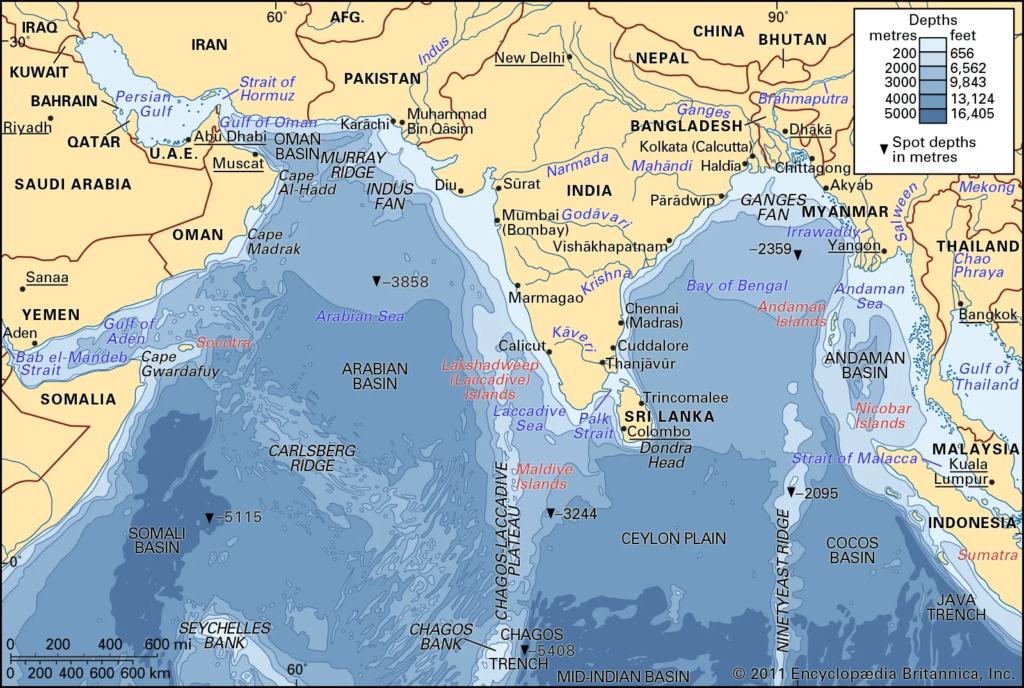The Bay of Bengal is the northeastern part of the Indian Ocean, bounded on the west and northwest by India, on the north by Bangladesh, and on the east by Myanmar and the Andaman and Nicobar Islands of India. It is 1000 miles or 1610 km wide at its broadest point and its maximum length is 2,088.9 kilometres. Possessing considerably deep waters, it has a depth of 15,400 ft or 4,694 m while its average water depth is around 2600 m or 8530 ft. Bays also form through coastal erosion by rivers and glaciers. The Bay of Bengal is the largest bay in the world with an area of about 839,000 square miles (2,173,000 square km). The Bay of Bengal is in the northeastern part of the Indian Ocean.
Which country owns the Bay of Bengal?
India: The Indian states of West Bengal, Odisha, Andhra Pradesh and Tamil Nadu have coastlines on the Bay of Bengal. India’s eastern military command is based in the port city of Kolkata, capital of erstwhile British India. Two of India’s busiest ports Chennai and Vizag are also located on the bay.

It is bordered by Sri Lanka and India to the west, Bangladesh to the north, and Myanmar (Burma) and the northern part of the Malay Peninsula to the east. The Bay of Bengal, the largest bay in the world, was formed by plate tectonics.
It is called the “Bay of Bengal”, because to the north are the Indian state of West Bengal and the country of Bangladesh. It is an extended part of the Indian Ocean, but part of the sea landed on part of Bangladesh. It has four sea ports on part of Bangladesh. The Bay of Bengal was named in the history of Bangladesh.

The Arabian sea is deeper than the Bay of Bengal. The average depth of the Arabian sea is 8970 feet (2734 m) and an average depth of Bay of Bengal is 8500 feet (2600 m).
What is the capital of Bay of Bengal?
The capital is Kolkata (Calcutta). Area 34,267 square miles (88,752 square km).
Is Bay of Bengal sea or ocean?
The Bay of Bengal, an arm of the northeastern Indian Ocean, is bordered by land masses — Sri Lanka, India, Bangladesh, Burma and the island chain: Andaman–Nicobar–Sumatra. A number of important rivers drain into the bay; the most important of these are the Ganges and Brahmaputra rivers
The largest bays have developed through plate tectonics. As the super-continent Pangaea broke up along curved and indented fault lines, the continents moved apart and left large bays; these include the Gulf of Guinea, the Gulf of Mexico, and the Bay of Bengal, which is the world’s largest bay.
Where is the most beautiful bay in the world?
Bay watch: 8 of the world’s most beautiful bays
- 1: Halong Bay, Vietnam.
- 2: Bay of Kotor, Montenegro.
- 3: Bay of Islands, New Zealand.
- 4: Paradise Bay, Antarctica.
- 5: Bay of Fundy, Canada.
- 6: Phang Nga Bay, Thailand.
- 7: Guanabara Bay, Brazil.
- 8: San Francisco Bay, USA.
What is the deepest bay in the world? The Bay of Bengal
The Bay of Bengal is the deepest bay in the world, with a max depth of 4,694 meters or 15,400 feet.
Why is the Bay of Bengal so hot?
First, mention the reasons as to why Bay of Bengal is the hot-bed for frequent cyclonic storms – The Bay of Bengal is shaped like a trough, high sea surface temperature, more rainfall with sluggish winds and warm air currents, constant inflow of fresh warm water etc.
What lives in the Bay of Bengal?
The fisheries of the Bay of Bengal LME target a wide range of species, including sardine, anchovy, scad, shad, mackerel, snapper, emperor, grouper, pike-eel, tuna, shark, shrimp, bivalve and other shellfish.
The Bay of Bengal is the northeastern part of the Indian Ocean, bounded on the west and northwest by India, on the north by Bangladesh, and on the east by Myanmar and the Andaman and Nicobar Islands of India. Its southern limit is a line between Sangaman Kanda, Sri Lanka, and the north westernmost point of Sumatra, Indonesia. It is the largest water region called a bay in the world. There are countries dependent on the Bay of Bengal in South Asia and Southeast Asia. During the existence of British India, it was named the Bay of Bengal after the historic Bengal region. At the time, the Port of Kolkata served as the gateway to the Crown rule in India. Cox’s Bazar, the longest sea beach in the world and Sundarbans, the largest mangrove forest and the natural habitat of the Bengal tiger, are located along the bay.
The Bay of Bengal occupies an area of 2,600,000 square kilometres (1,000,000 sq mi). A number of large rivers flow into the Bay of Bengal: the Ganges–Hooghly, the Padma, the Brahmaputra–Yamuna, the Barak–Surma–Meghna, the Irrawaddy, the Godavari, the Mahanadi, the Brahmani, the Baitarani, the Krishna and the Kaveri.
